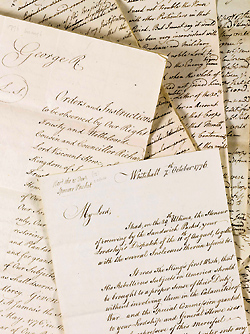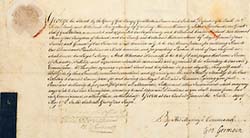The personal and official papers of a high-ranking British diplomat who participated in the Treaty of Paris (1783-84) with the American colonies, which formally ended the Revolutionary War, now are an essential part of the archives of the William L. Clements Library.
The papers from the Sir Henry Strachey Collection were purchased Oct. 15 at Sotheby’s auction of the James S. Copley Library. Strachey was from one of Britain’s preeminent families, and was a noted civil servant who held several prominent posts in the British government.


The William L. Clements Library recently acquired Revolutionary War papers from the Sir Henry Strachey Collection. The Strachey papers will be available to the public in the next several months. Photos courtesy Sotheby’s.
It is rare today to see a large collection of American Revolution manuscripts come on the market,” says J. Kevin Graffagnino, director of the Clements Library. “Adding the Strachey material to the voluminous primary sources already at the Clements makes the library even more attractive as a destination for all researchers working on Revolutionary War topics.”
Specifically, the Strachey papers document his work in attempting to negotiate peace between the colonies and England in 1775-76 and during the negotiations that led to the 1783 Treaty of Paris. The papers, Graffagnino says, give a perspective from the British side, at the highest level of strategy and negotiation. John Adams, Benjamin Franklin and John Jay represented the colonies at the negotiations, held in Paris.
Strachey’s papers shed light on English investments in North America, and the social history of the late 18th-century available for the first time to researchers, he says.
In the next several months, the Strachey papers will be available to the public. The archives are open to the public and scholars researching the seminal events, personalities and issues that forged the early years of the United States.
The Clements Library houses original resources for the study of American history and culture from the 15th through the 19th century. Its mission is to collect and preserve primary source materials, to make them available for research, and to create an environment that supports and encourages scholarly investigation of our nation’s past.
“In purchasing the Strachey papers, we have closed the book on an acquisitions hunt that began more than 70 years ago,” says Graffagnino, who noted Randolph Adams, first director of the library, saw the Strachey collection in England in the late 1920s, but he was unable to persuade Henry Strachey’s descendants to part with them.
The Clements Library bought half of the papers at auction in 1982, but the other half went to the Copley Foundation six years later, Graffagnino says.
“Now the two halves are reunited, making a rich array of unpublished material on Anglo-American relations and events of the American Revolution,” he says.

